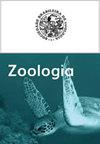Encounter rate and behavior of Alouatta guariba clamitans in the Ilha Grande State Park, Rio de Janeiro state, Brazil
IF 1.8
4区 生物学
Q4 ZOOLOGY
引用次数: 1
Abstract
Alouatta guariba clamitans Cabrera, 1940 is an endemic species of the Atlantic Forest that occurs from south Bahia, Brazil, extending south to the province of Misiones, Argentina. In Rio de Janeiro state, the species was classified as threatened, indicating that attention is needed for the conservation of this taxon. Additionally, an outbreak of yellow fever spread throughout the southeastern states of Brazil from January 2017 until March 2018 seriously threatening Rio de Janeiro populations of the species. Herein, we aimed to provide the first estimates of A. g. clamitans encounter rate, density, and population size in the Ilha Grande State Park (PEIG), which is part of the Atlantic Forest biome of Brazil. Data were collected in two different periods, the first between December 2003 and May 2005, and the second from August 2009 to May 2010, and information on encounter rates and behavior was collected to better understand aspects of species’ ecology. The estimated encounter rate in the first period through the distance sampling method was 0.04 ± 0.01 individuals per kilometer. Nine groups were recorded in the second period of the study, with 47 individuals along 3 km. Our estimates of encounter rate, density and population size were low and reinforces the need to initiate species monitoring and assess the impact that yellow fever outbreaks may have on PEIG populations. The results presented here can be a starting point to support future strategic actions for the species, to measure impacts and to the management of the species, and for a conservation program.巴西里约热内卢州伊尔哈格兰德州立公园的Alouatta guariba clamitans的相遇率和行为
Alouatta guariba clamitans Cabrera, 1940是大西洋森林的特有物种,产于巴西巴伊亚州南部,向南延伸到阿根廷米西奥内斯省。在巴西里约热内卢州,该物种被列为受威胁物种,表明需要注意保护该分类群。此外,2017年1月至2018年3月期间,黄热病疫情在巴西东南部各州蔓延,严重威胁到巴西里约热内卢的该物种种群。在此,我们的目的是提供伊尔哈格兰德州立公园(PEIG)中a.g. clamitans相遇率,密度和种群规模的首次估计,该公园是巴西大西洋森林生物群系的一部分。在2003年12月至2005年5月和2009年8月至2010年5月两个不同的时期收集了数据,收集了相遇率和行为的信息,以更好地了解物种生态的各个方面。通过距离采样法估计第一期的偶遇率为0.04±0.01个体/公里。在研究的第二阶段,记录了9组,47个人沿着3公里。我们对偶遇率、密度和种群规模的估计较低,这加强了启动物种监测和评估黄热病疫情可能对北京猪种群产生的影响的必要性。这里提出的结果可以作为一个起点,以支持未来的物种战略行动,衡量影响和物种管理,以及保护计划。
本文章由计算机程序翻译,如有差异,请以英文原文为准。
求助全文
约1分钟内获得全文
求助全文
来源期刊

Zoologia
生物-动物学
自引率
0.00%
发文量
15
期刊介绍:
Zoologia, the scientific journal of the Sociedade Brasileira de Zoologia (SBZ), is an international peer-reviewed, open-access Zoological journal that publishes original research on systematics, evolution, taxonomy, nomenclature, biogeography, morphology, physiology, biology, ecology, symbiosis, conservation, behavior, genetics and allied fields. The journal, formerly known as Revista Brasileira de Zoologia, publishes original articles authored by both members and non-members of the Society. The manuscripts should be written exclusively in English.
 求助内容:
求助内容: 应助结果提醒方式:
应助结果提醒方式:


